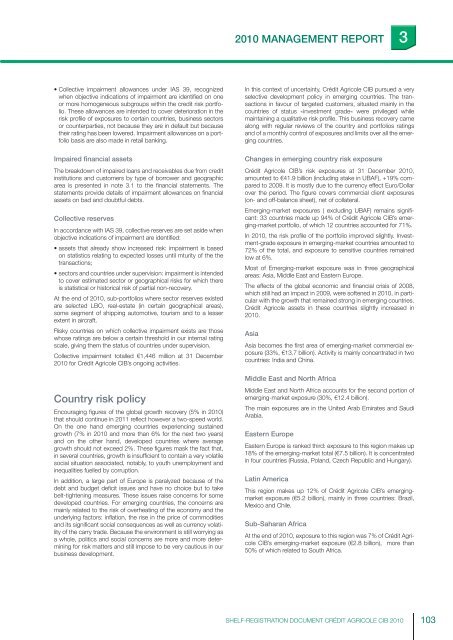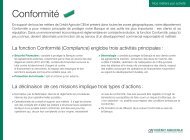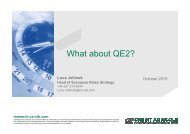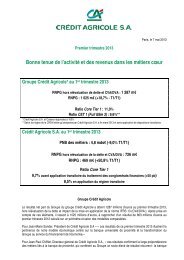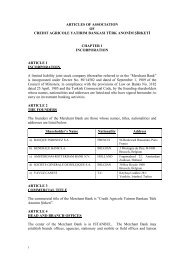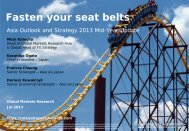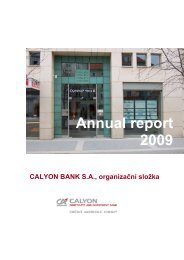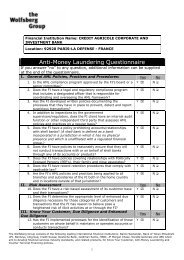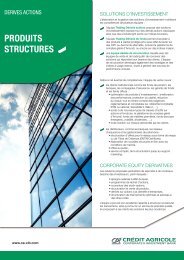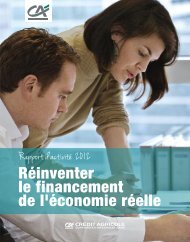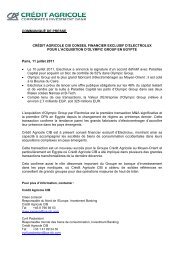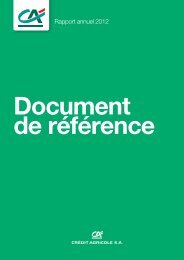ourexpertise - Crédit Agricole CIB
ourexpertise - Crédit Agricole CIB
ourexpertise - Crédit Agricole CIB
You also want an ePaper? Increase the reach of your titles
YUMPU automatically turns print PDFs into web optimized ePapers that Google loves.
2010 MANAGEMENT REPORT 3• Collective impairment allowances under IAS 39, recognizedwhen objective indications of impairment are identifi ed on oneor more homogeneous subgroups within the credit risk portfolio.These allowances are intended to cover deterioration in therisk profi le of exposures to certain countries, business sectorsor counterparties, not because they are in default but becausetheir rating has been lowered. Impairment allowances on a portfoliobasis are also made in retail banking.Impaired financial assetsThe breakdown of impaired loans and receivables due from creditinstitutions and customers by type of borrower and geographicarea is presented in note 3.1 to the fi nancial statements. Thestatements provide details of impairment allowances on fi nancialassets on bad and doubtful debts.Collective reservesIn accordance with IAS 39, collective reserves are set aside whenobjective indications of impairment are identifi ed:• assets that already show increased risk: impairment is basedon statistics relating to expected losses until mturity of the thetransactions;• sectors and countries under supervision: impairment is intendedto cover estimated sector or geographical risks for which thereis statistical or historical risk of partial non-recovery.At the end of 2010, sub-portfolios where sector reserves existedare selected LBO, real-estate (in certain geographical areas),some segment of shipping automotive, tourism and to a lesserextent in aircraft.Risky countries on which collective impairment exists are thosewhose ratings are below a certain threshold in our internal ratingscale, giving them the status of countries under supervision.Collective impairment totalled €1,446 million at 31 December2010 for <strong>Crédit</strong> <strong>Agricole</strong> <strong>CIB</strong>’s ongoing activities.In this context of uncertainty, <strong>Crédit</strong> <strong>Agricole</strong> <strong>CIB</strong> pursued a veryselective development policy in emerging countries. The transactionsin favour of targeted customers, situated mainly in thecountries of status « investment grade« were privileged whilemaintaining a qualitative risk profi le. This business recovery camealong with regular reviews of the country and portfolios ratingsand of a monthly control of exposures and limits over all the emergingcountries.Changes in emerging country risk exposure<strong>Crédit</strong> <strong>Agricole</strong> <strong>CIB</strong>’s risk exposures at 31 December 2010,amounted to €41.9 billion (including stake in UBAF), +19% comparedto 2009. It is mostly due to the currency effect Euro/Dollarover the period. The fi gure covers commercial client exposures(on- and off-balance sheet), net of collateral.Emerging-market exposures ( excluding UBAF) remains signifi -cant: 33 countries made up 94% of <strong>Crédit</strong> <strong>Agricole</strong> <strong>CIB</strong>’s emerging-marketportfolio, of which 12 countries accounted for 71%.In 2010, the risk profi le of the portfolio improved slightly. Investment-gradeexposure in emerging-market countries amounted to72% of the total, and exposure to sensitive countries remainedlow at 6%.Most of Emerging-market exposure was in three geographicalareas: Asia, Middle East and Eastern Europe.The effects of the global economic and fi nancial crisis of 2008,which still had an impact in 2009, were softened in 2010, in particularwith the growth that remained strong in emerging countries.<strong>Crédit</strong> <strong>Agricole</strong> assets in these countries slightly increased in2010.AsiaAsia becomes the fi rst area of emerging-market commercial exposure(33%, €13.7 billion). Activity is mainly concentrated in twocountries: India and China.Middle East and North AfricaCountry risk policyEncouraging fi gures of the global growth recovery (5% in 2010)that should continue in 2011 refl ect however a two-speed world.On the one hand emerging countries experiencing sustainedgrowth (7% in 2010 and more than 6% for the next two years)and on the other hand, developed countries where averagegrowth should not exceed 2%. These fi gures mask the fact that,in several countries, growth is insuffi cient to contain a very volatilesocial situation associated, notably, to youth unemployment andinequalities fuelled by corruption.In addition, a large part of Europe is paralyzed because of thedebt and budget defi cit issues and have no choice but to takebelt-tightening measures. These issues raise concerns for somedeveloped countries. For emerging countries, the concerns aremainly related to the risk of overheating of the economy and theunderlying factors: infl ation, the rise in the price of commoditiesand its signifi cant social consequences as well as currency volatilityof the carry trade. Because the environment is still worrying asa whole, politics and social concerns are more and more determiningfor risk matters and still impose to be very cautious in ourbusiness development.Middle East and North Africa accounts for the second portion ofemerging-market exposure (30%, €12.4 billion).The main exposures are in the United Arab Emirates and SaudiArabia.Eastern EuropeEastern Europe is ranked third: exposure to this region makes up18% of the emerging-market total (€7.5 billion). It is concentratedin four countries (Russia, Poland, Czech Republic and Hungary).Latin AmericaThis region makes up 12% of <strong>Crédit</strong> <strong>Agricole</strong> <strong>CIB</strong>’s emergingmarketexposure (€5.2 billion), mainly in three countries: Brazil,Mexico and Chile.Sub-Saharan AfricaAt the end of 2010, exposure to this region was 7% of <strong>Crédit</strong> <strong>Agricole</strong><strong>CIB</strong>’s emerging-market exposure (€2.8 billion), more than50% of which related to South Africa.SHELF-REGISTRATION DOCUMENT CRÉDIT AGRICOLE <strong>CIB</strong> 2010 103


